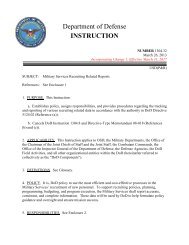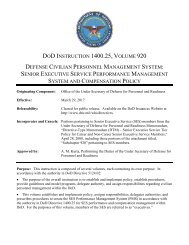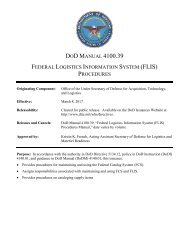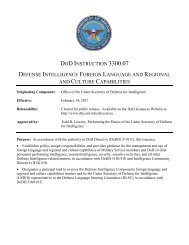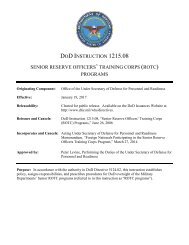520045m
520045m
520045m
Create successful ePaper yourself
Turn your PDF publications into a flip-book with our unique Google optimized e-Paper software.
DoDM 5200.45, April 2, 2013<br />
(12) Information concerning relationships with foreign intelligence organizations or<br />
related to foreign collection activities (see also section 3 of this enclosure which addresses<br />
intelligence classification considerations).<br />
c. Classification Guide Illustrations. The discussion on classifying details in Appendix 3 to<br />
Enclosure 2 and the recommended format for a security classification guide in Enclosure 4 of<br />
this Manual are applicable to DoD development of a foreign relations security classification<br />
guide. Subparagraphs 4.c.(1) through 4.c.(3) provide examples of the impact that foreign<br />
government information might have on the development of classification guidance.<br />
(1) A DoD Component is involved in negotiating an arrangement with country “X.” In<br />
the process of the negotiations, the foreign counterpart states that his country does not want<br />
discussion on the subject to become public knowledge. At the same time, the foreign official<br />
makes it clear that his country has announced publicly its intention to seek U.S. views on the<br />
subject of the discussions. The nature of business being discussed is such that the United States<br />
would not require the fact of the discussions be protected from public disclosure. Moreover, the<br />
subject matter is one that would not ordinarily be classified. The DoD Component, however,<br />
does classify the notes and transcripts pertaining to the discussion because of the expressed<br />
wishes of the foreign government. The information fits the description of foreign government<br />
information. Thus, a classification guide on the subject might contain topics as shown in Table 8<br />
of this enclosure. Remember that use of an exemption (25X1 through 25X9) for the duration of<br />
classification as shown in this example requires ISCAP approval prior to use and citation of a<br />
declassification date or event (see Enclosure 2, paragraph 2.b for further guidance).<br />
(2) The scenario in paragraph 4.c.(1) and in Table 9 illustrates a brief classification guide<br />
involving the foreign relations of the United States as well as foreign government information.<br />
The guide could not have been written before negotiations were underway because the foreign<br />
official only made the two critical elements of information known during the negotiations. A<br />
classification guide such as this one, brief as it is, can serve a very useful purpose when, for<br />
example, it is anticipated that the negotiations will involve a large number of personnel from<br />
several U.S. agencies and will last several years.<br />
(3) Note that, when previously approved by the ISCAP, exemption 25X9 with a<br />
declassification date or event could also be cited for the duration if declassification would violate<br />
a statute, treaty, or international agreement that does not permit the automatic or unilateral<br />
declassification of information at 25 years. Identify the specific statute, treaty or international<br />
agreement in the declassification instructions.<br />
40<br />
ENCLOSURE 3



